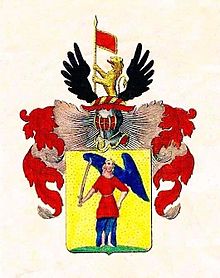Angels (noble family)
Engel is the name of an aristocratic family from Mecklenburg , who first came to their nobility in Sweden , and later spread to Saxony , Livonia and Austria .
The family is not to be confused with the eponymous Bremen's family, which in 1656 also in Sweden ennobled was. Nor is there any family connection with the family of the same name, which was also ennobled in Austria in 1808.
history
The secured lineage of the family already begins with Jakob Engel (* 1545), born in Neubrandenburg , whose descendant Joachim Engel, pledgee of Klein Helle and his brother, Hans Engel, lord of Gevezin and Podewall , both royal Swedish colonels, on November 18, 1662 were raised to the Swedish nobility in Stockholm .
The royal Danish captain and lord of Breesen , Hans David Engel, was raised to knightly imperial nobility for the Mecklenburg line in Vienna on December 17, 1739. His son Karl von Engel, heir to Breesen, was accepted into the Mecklenburg knighthood in 1790 and 1798 respectively.
In the registration book of the Dobbertin monastery there are 16 entries by daughters of the von Engel families from Breesen, Eichhorst and Wamckow from 1799–1913 for inclusion in the local aristocratic women's monastery .
On July 9, 1851, Vienna received another diploma for the Austrian knighthood for the imperial and royal major Julius von Engel, as a knight of the Iron Crown Order 3rd class.
From the line that had spread to Saxony was Carl August Maximilian von Engel, from 1849 royal Saxon lieutenant general, royal adjutant general and head stable master.
Lieutenant Carl August von Engel bought the Somel estate in the Torma parish in Livonia for himself and his family on December 12th . Although a Swedish ennobling background is undisputed, it was not possible to clearly determine whether he belonged to the Mecklenburg or further to the Bremen von Engel family.
On May 9, 1903, the Rittmeister Carl Georg Alfred von Engel acquired the Lehngut Wamckow from Ernst von Bülow-Trümmer for 52,000 marks in cash. The von Engels managed the estate until they escaped on April 17, 1945.
possession
Ledebur gives a rough overview of the historical property ownership of the family :
- In Mecklenburg: Breesen, Dolzin ( wüst ), Drüsewitz , Eichhorst , Feldberg , Gevezin, Gubkow , Groß and Klein Helle , Kalübbe and Neuhof, Labs, Niegleve and Zierhagen , Groß Niekör , Podewall, Tolzin , Wamckow and Wrodow
- In Pomerania: Fritzow
- In Livonia: Somel
coat of arms
The family coat of arms (1662) shows in gold on green ground a forward-facing, blue-winged, gold-curled angel in a red overcoat and blue undergarment, with a sword in his right hand. On the helmet with red and gold covers, between an open black flight, a growing golden lion holding a gold-fringed, red flag with both paws.
The coat of arms (1739, 1851) shows the shield like the family coat of arms, but the angel's dress split in red and blue . Two helmets: the right one identical to the family coat of arms, on the left one with blue and gold covers, five alternating gold and blue ostrich feathers .
For the Saxon line, Ledebur emblazoned the Archangel Michael with a dragon in his shield. Kneschke, in turn, considers this to be a mistake.
Known family members
- Carl August Maximilian von Engel (* 1795, † after 1849), royal Saxon lieutenant general, adjutant general and head stable master
- Adolf von Engel (1834–1900), owner of a majorate and member of the German Reichstag
- Hans von Engel (1838–1905), Prussian major general
- Hartwig von Engel (1873–1926), district administrator and member of parliament
- Max Karl von Engel (1834–1905), Mecklenburg District Administrator and Land Marshal
literature
- Genealogical manual of the nobility . Volume 36 of the complete series, (1965); Nobility Lexicon. Volume III, Volume 61 of the complete series, Limburg (Lahn) 1975, pp. 146-147.
- Genealogical paperback of noble houses in Austria . 1808/1809. (older genealogy)
- Genealogical paperback of the knight and noble families. Brno 1870 to 1894.
- Gothaisches Genealogisches Taschenbuch der Nobligen houses . (AB) Gotha 1914 (lineage and older genealogy), until 1940 (continuations)
- Gustav von Lehsten: The nobility of Mecklenburg since the constitutional hereditary comparisons (1755). Rostock 1864, pp. 63-64.
- Peter Mugay: The angels. In: Wamckow. A Mecklenburg Gutsdorf through the ages. Wamckow 2001, pp. 106-149.
Web links
- Literature about angels (noble family) in the state bibliography MV
- Castle archive Wildenfels family v. Angel
Individual evidence
- ^ A b c Ernst Heinrich Kneschke : New general German nobility lexicon . Volume 3, Leipzig 1861, p. 112.
- ↑ Nobility Lexicon . Volume III, (1975), p. 147.
- ^ Maximilian Gritzner : New screen maker . Volume 3, Section 11: The Nobility of the Russian Baltic Sea Provinces. Part 2: The non-enrolled nobility. Nuremberg 1901, p. 37, Tfl. 29
- ^ Leonhard von Stryk : Contributions to the history of the manors of Livonia. Volume 1: The Estonian District. Dorpat 1877, p. 146.
- ↑ Leopold von Ledebur : Adelslexikon der Prussischen Monarchy . Volume 1, Berlin 1855, p. 204.
- ↑ Leopold von Ledebur: Adelslexikon der Prussischen Monarchy. Volume 3, Berlin 1858, p. 248.

